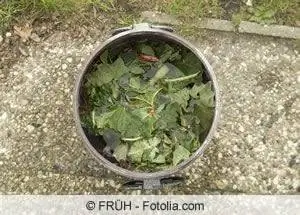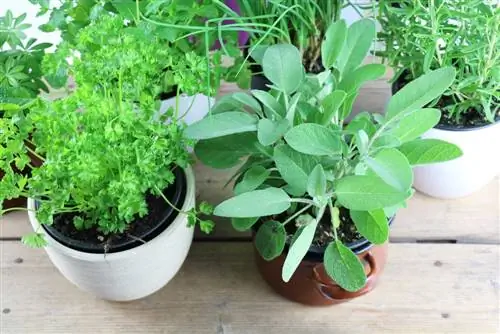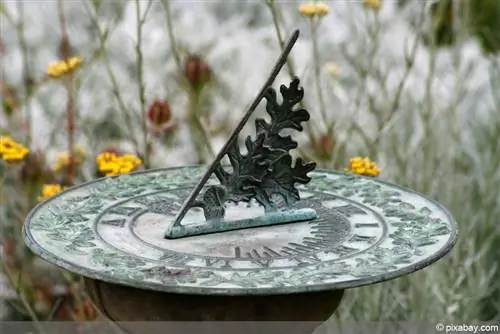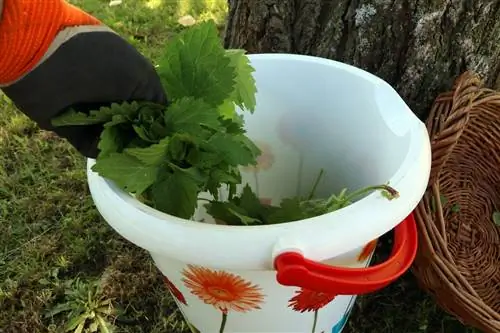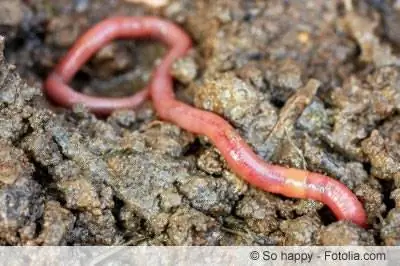- Author admin [email protected].
- Public 2023-12-17 03:39.
- Last modified 2025-06-01 06:48.
The nettle plant is considered one of the magical plants in popular belief and is a wonderful plant that is considered a weed by many hobby gardeners. It can be so helpful in the garden. Our ancestors used their manure and many a grandmother will tell her grandchildren how she had to make the nettle manure herself as a young girl. The nettle and its manures and extracts are effective products that have proven themselves both as biological fertilizers and as a means against aphids.
Manure or broth?
In many places, hobby gardeners do not really agree on which approach can or must be used against aphids in order to achieve results. Both - nettle manure and nettle broth - are used against aphids. Nettle manure as a strengthening agent for the plants so that they can better defend themselves against aphids and nettle broth as an insecticide that has a direct effect against the sucking aphids and their eggs and larvae.
Tools and materials
The same materials are required to make nettle manure and nettle broth:
- Wooden tub, rain barrel or barrel
- thick gardening gloves
- Garden scissors
- Garden sprayer
- Garden hose
- long wooden stick for stirring
- Grid or lid to cover the vessel
- old board or lid
- Rock powder or valerian extract
- alternatively: lavender branches or other fragrant flowers
Tip:
Do not use a metal container to plant the nettles, as chemical processes are set in motion between the metal and the nettle liquid.
Stinging nettle manure
The nettle manure is more about using the silica and nitrogen it contains and not about the formic acid from the nettle cells. The manure serves more to strengthen the plants infected with aphids.
Planting the nettles
The nettles should be cut during or before flowering. Approximately 10 kg of fresh or 1 kg of dried nettles are added to approx. 50 l of water. First chop the nettles. You can use any part of the plant, including the old stems. Then layer the crushed nettles layer by layer in the container provided, which should be in the sun if possible and ideally far from the house in the farthest corner of the garden. If the container is in the sun during fermentation, the process will go faster. After each layer, tamp down the nettles and add the next layer of plant material on top until all the nettles are in the container. Then fill the container with rainwater or, if this is not available, with tap water. Finally, cover the container with a grid or rabbit wire to prevent animals from falling into the manure. To prevent leaves from falling in, it is best to place a board or a lid over it.
Tip:
Only fill the container up to four-fifths, as after a while the manure will begin to ferment, creating foam that takes up space.

Stir regularly
Now stir the manure well every day so that enough oxygen can enter the fermentation process. As soon as this process begins, bubbles form and rise. Ultimately, foam forms on the surface of the manure. In addition, a very unpleasant smell arises, which you can contain and bind with a little valerian flower extract or a handful of rock dust. Alternatively, you can use lavender branches with flowers and other strongly scented flowering plants instead. Don't forget to stir well every day. As soon as the manure no longer foams, no more bubbles appear and it has acquired a dark color, it is ready. Until then, about 12 to 14 days have passed.
Diluting the nettle manure
The finished nettle manure is now diluted with water in a ratio of 1:10 for older plants and 1:20 for seedlings and young plants.
Watering the plants
On cloudy days, pour these mixtures onto the root area of the respective plants that are infested with aphids. This strengthens them from the inside out against the sucking insects. You can also use it to water plants that are not yet infested with aphids. Nettle manure is a very good fertilizer and makes the plants resilient so that the aphids can harm them less or nothing.
Tip:
Do not water the nettle manure in full sunshine. Otherwise the leaves will burn if some manure gets on them.
Effects of nettle manure
The nettle manure acts like a mild, harmonious nitrogen fertilizer. It has a healing and balancing effect, stimulates chlorophyll formation and promotes growth. If the plants are he althy, pests such as sucking aphids can hardly harm them.
Which plants can be watered with it?
- most of the flowers
- Shrubs
- Trees
- Houseplants
- Vegetable plants
Which plants should not be watered with it?
- garlic
- Onions
- Peas
- Beans
Why does manure have a strengthening effect?
In nettle manure, the nitrogen that plants such as heavy-feeding vegetable plants need for their growth and fruit setting is largely in the form of ammonium ions. Due to the high pH value of the nettle manure, the ammonium ions are absorbed more efficiently by the plants.
Nettle broth
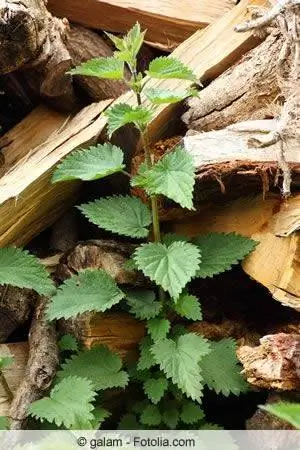
The nettle broth, sometimes also called nettle cold water extract, is prepared in the same way as the nettle manure. However, only 1 kg of fresh nettles are added to 5 liters of water. The procedure is the same as for making manure, but with the difference that the broth only has to stand for 12 to 24 hours. It shouldn't start fermenting yet! Because here emphasis is placed on the nettle poison, which is supposed to drive away the aphids. This nettle broth is sprayed undiluted onto plants infected with aphids. However, just like with manure, you should make sure that you do not spray the plants in the blazing sun. An overcast day is preferable! You should also make sure that you spray the plants regularly and even when the aphids are no longer visible. Under no circumstances should you use the fermented nettle manure to spray the plants, only use the broth.
Tip:
In addition to nettles, thyme, sage, wormwood, tansy and lavender are also suitable for pest control, the cold water extracts of which are produced in exactly the same way as the nettle broth.
Why is nettle broth effective against aphids?
The nettle has so-called stinging hairs, which act like a protective mechanism against predators. These are predominantly present on the upper side of the leaf. The long, single-celled tubes have silica embedded in their walls, which makes them very brittle, like glass. In the lower, slightly more flexible end is the so-called fuel fluid or, more precisely, the nettle poison, which causes itching and burning on the skin. The liquid - nettle poison - is primarily a cocktail of formic acid, acetylcholine, histamine, sodium formate and serotonin. In humans, around 100 ng of the liquid is enough to achieve the well-known effect. This liquid works very well as a natural insect repellent. By chopping and crushing the nettles and soaking them in water, the liquid is released.
Conclusion
Nettle manure and nettle broth are easy to make yourself. You should just make sure that you do not use the manure undiluted, while you can use the broth undiluted. It is also important that you do not use a metal container for the approaches, otherwise a chemical reaction will be triggered. And also make sure that you put on gloves, both when picking the nettle and when preparing the manure. Then nothing should go wrong!

